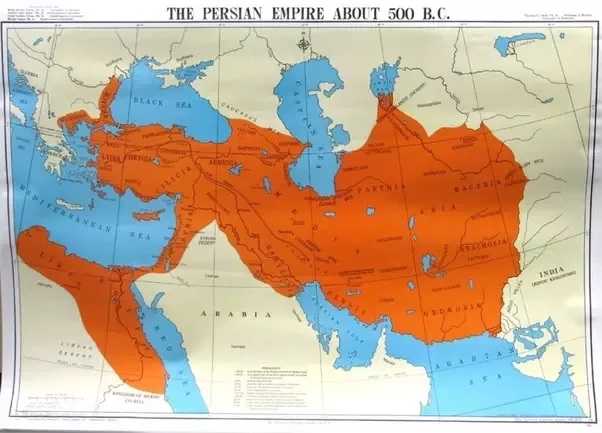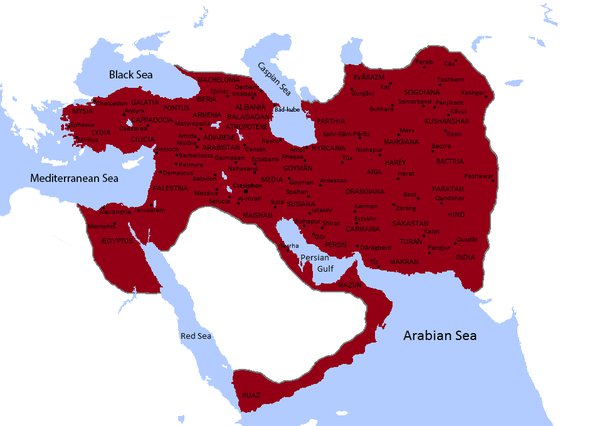The Persian Empire, one of the greatest empires in ancient history, stretched across vast lands and left a lasting impact on civilization. It is intriguing to delve into the question of how big this empire truly was and explore its significance.
In order to understand the sheer size of the Persian Empire, we must consider its territorial expanse. At its height, the empire encompassed an area of approximately 5.5 million square kilometers, making it the largest empire of its time. To put this into perspective, that is about three times the size of the Roman Empire. Such a vast territory allowed the Persians to exert their influence over diverse regions, from Egypt to India, uniting a wide range of cultures under their rule.
The Persian Empire, at its height, spanned across 5.5 million square kilometers. It was one of the largest empires in ancient history, stretching from Egypt in the west to India in the east. It included present-day Iran, Iraq, Turkey, and parts of Central Asia. Under the reign of Cyrus the Great, the Persian Empire reached its zenith, encompassing diverse cultures and flourishing trade routes.

Contents
The Vastness of the Persian Empire
The Persian Empire, also known as the Achaemenid Empire, was one of the largest and most influential empires in ancient history. Spanning from the eastern Mediterranean to the Indus River Valley, it covered a vast territory and consisted of diverse regions, cultures, and peoples. In order to understand the magnitude of the Persian Empire, it is essential to explore the various aspects that contributed to its immense size and power.
Territorial Expansion and Conquests
The initial territory of the Persian Empire around 550 BCE was relatively small, encompassing the region of Parsa in southwestern Iran. However, under the leadership of Cyrus the Great, the empire began its expansion. Through a series of military conquests, Cyrus and subsequent Persian kings expanded their borders, incorporating lands and peoples from numerous civilizations.
One of the most significant conquests of the Persian Empire was the annexation of the Neo-Babylonian Empire in 539 BCE. This conquest, led by Cyrus the Great, marked the incorporation of Mesopotamia into the Persian Empire, further expanding its reach. The empire continued its expansion into Egypt, Anatolia, and Central Asia under the rule of Darius the Great, reaching its peak during the Achaemenid dynasty.
The Persian Empire’s territorial expanse was vast, stretching from the Balkans in the west to the Indus River Valley in the east. It included regions such as modern-day Iran, Iraq, Syria, Lebanon, Israel, Jordan, Egypt, Turkey, and parts of Greece, Afghanistan, Pakistan, and Central Asia. This vast territory made the Persian Empire one of the largest land empires in history.
The Persian Empire’s conquests were not limited to land; it also extended its influence across the seas. The Persians established control over strategic coastal regions, which allowed them to dominate maritime trade routes in the Mediterranean and the Red Sea. This enabled them to project their power and ensure the stability and prosperity of their vast empire.
Administration and Governance
The administration and governance of the Persian Empire were remarkable in their ability to maintain such a vast territory. The empire was divided into provinces called satrapies, each governed by a satrap appointed by the king. This decentralized system allowed for local autonomy while ensuring loyalty to the central Persian authority.
The satraps were responsible for collecting taxes, maintaining order, and defending their territories. They had the authority to make decisions regarding local affairs, but ultimate power rested with the Persian king. In addition to the satraps, the empire had a network of officials responsible for overseeing various administrative functions, such as finance, infrastructure, and justice.
The Persian Empire was known for its efficient administration and its ability to incorporate diverse cultures and peoples into its vast domain. It embraced a policy of religious and cultural tolerance, allowing conquered peoples to retain their customs, languages, and some degree of autonomy. This approach helped maintain stability within the empire and facilitated the assimilation of different cultures.
Moreover, the Persians were innovative in their use of communication systems, such as the Royal Road, which connected various parts of the empire. This facilitated the movement of officials, messengers, and trade goods, contributing to the efficiency of governance and the flow of information throughout the empire.
Cultural and Artistic Contributions
The immense size and diversity of the Persian Empire allowed for the exchange and dissemination of ideas, customs, and artistic expressions. Persian art and architecture, heavily influenced by the civilizations it absorbed, left a lasting impact on the regions under its rule.
One of the most renowned Persian architectural achievements was the construction of Persepolis, the ceremonial capital of the empire. The imposing palaces, grand staircases, and intricate reliefs showcased the wealth and power of the Persian kings. The empire also developed an innovative construction technique called “pisé,” which utilized sundried mud bricks and contributed to the longevity of its structures.
Persian literature and poetry flourished during the empire’s rule. One of the most famous works of Persian literature is the epic poem “Shahnameh” (Book of Kings) by Ferdowsi, which chronicles the mythical and historical stories of Persia. This literary masterpiece continues to be celebrated as a valuable contribution to world literature.
The Persian Empire’s artistic and cultural legacy can also be seen in its influence on neighboring civilizations. Elements of Persian art, such as motifs and decorative patterns, were adopted and incorporated into the art and architecture of various cultures, including Hellenistic, Egyptian, and Indian civilizations.
Legacy and Influence
The Persian Empire’s vast size and its contributions to governance, culture, and art left a lasting legacy and exerted a significant influence on subsequent civilizations. Its administrative system inspired future empires, such as the Macedonian Empire under Alexander the Great and the Roman Empire. The concept of religious and cultural tolerance also influenced later rulers, including the Persian-influenced Mughal Empire in India.
Furthermore, the Persian Empire’s impact on trade and commerce reverberated throughout the ancient world. The establishment of stable trade routes and the integration of diverse regions fostered economic prosperity and cultural exchange. In particular, the significance of Persian control over vital trade routes, such as the Silk Road, contributed to the growth of global trade networks.
The Persian Empire’s enduring influence can be seen in various aspects of modern Persian culture. Persian cuisine, art, music, and literature continue to thrive, reflecting the rich heritage of the Achaemenid Empire. The Persian language, Farsi, is still spoken today and has influenced neighboring languages in the region.
In conclusion, the Persian Empire’s vastness cannot be underestimated. Its territorial expansion, efficient governance, cultural contributions, and enduring legacy shaped the course of ancient history and continue to resonate in today’s world.

Size of the Persian Empire
The Persian Empire, also known as the Achaemenid Empire, was one of the largest empires in ancient history. Stretching from modern-day Iran to Egypt and into present-day Turkey, it was a vast empire that dominated the ancient world from approximately 550 to 330 BCE.
At its height, the Persian Empire covered an estimated area of around 5.5 million square kilometers (2.1 million square miles). This immense size made it the largest empire of its time, surpassing even the mighty Roman Empire.
The Persian Empire consisted of numerous territories and regions, including Persia (Iran), Mesopotamia, Egypt, Anatolia, and parts of Central Asia and the Caucasus. It incorporated diverse cultures, languages, and civilizations, making it one of the most diverse and cosmopolitan empires in history.
Under the rule of powerful kings, such as Cyrus the Great and Darius I, the Persian Empire flourished. It boasted advanced infrastructure, efficient governance, and a strong military. This allowed it to maintain control over its vast territories and exert influence over surrounding regions.
Key Takeaways – How Big Was the Persian Empire:
- The Persian Empire was one of the largest empires in world history.
- At its peak, the Persian Empire spanned three continents: Asia, Africa, and Europe.
- The empire stretched from Greece and Egypt in the west to India and Central Asia in the east.
- It covered an area of approximately 5 million square kilometers.
- The Persian Empire was known for its centralized government and efficient administration.
Frequently Asked Questions
Below are some commonly asked questions about the size of the Persian Empire.
1. How expansive was the Persian Empire?
The Persian Empire was one of the largest empires in the ancient world, covering a vast territory that stretched from Egypt and Anatolia in the west to the Indus Valley in the east. At its height, it encompassed approximately 5.5 million square kilometers, making it one of the largest empires in history.
Such an extensive empire allowed the Persians to control diverse regions, encompassing numerous different cultures, languages, and peoples.
2. Which territories were part of the Persian Empire?
The Persian Empire comprised a vast collection of territories, including modern-day Iran, Iraq, Turkey, Egypt, parts of Pakistan, Afghanistan, and Central Asia.
This sprawling empire incorporated various regions and kingdoms, each with their unique customs and traditions.
3. How did the Persian Empire grow so large?
The Persian Empire gradually expanded through a combination of military conquests and political alliances. The empire was led by successive powerful rulers who undertook ambitious campaigns to annex neighboring territories and extend their influence.
Furthermore, the Persians were skilled diplomats, often employing strategic alliances and treaties to consolidate their power and ensure the loyalty of subject territories. Over time, this led to the significant growth and size of the empire.
4. Did the Persian Empire control other civilizations?
Yes, the Persian Empire exerted control over numerous civilizations, which contributed to its vast size. Notable examples include the ancient civilizations of Mesopotamia, Egypt, and the Indus Valley.
The Persians often adopted a policy of tolerance and allowed local cultures and religions to flourish under their rule, fostering a sense of unity and stability within the empire.
5. How did the Persian Empire manage such a large territory?
The Persian Empire employed a sophisticated administrative system to govern its extensive territory. They divided the empire into provinces, each governed by a satrap who had the authority to collect taxes and maintain order.
The Persians also built a network of roads and established an efficient communication system, allowing them to maintain control and coordinate activities across their vast empire.
The Persian Empire Explained in 9 Minutes
So, now you have a clear idea of how big the Persian Empire was. It stretched across a vast territory, spanning from modern-day Turkey in the west to parts of India in the east, and from the Black Sea in the north to Egypt in the south. It was one of the largest empires in history.
The Persian Empire’s geographical size was impressive, but its influence extended far beyond its borders. It played a significant role in shaping the ancient world, leaving a lasting impact on politics, culture, and trade. From the city of Persepolis to the Royal Road, the Persian Empire’s legacy continues to intrigue and fascinate us today.